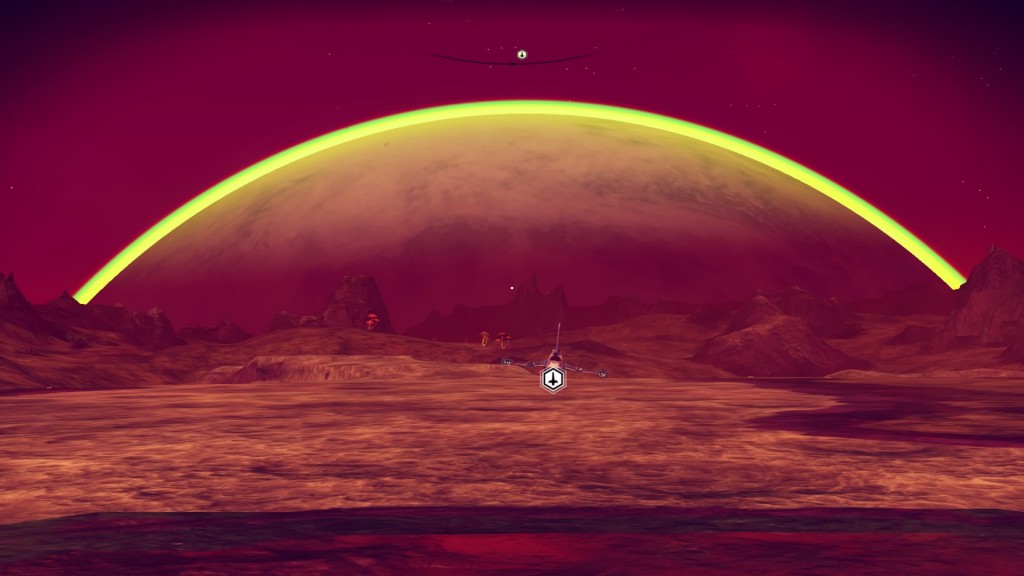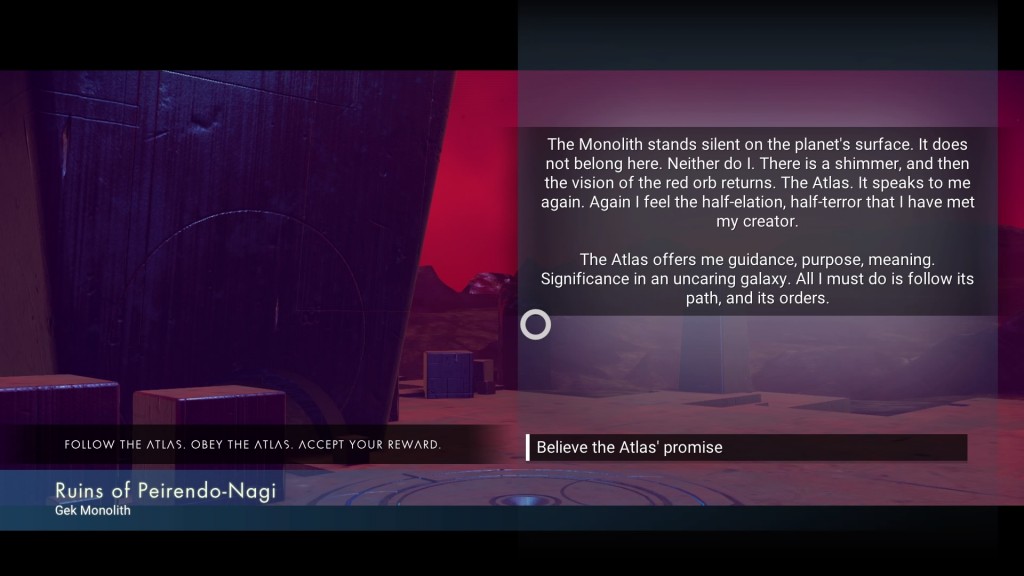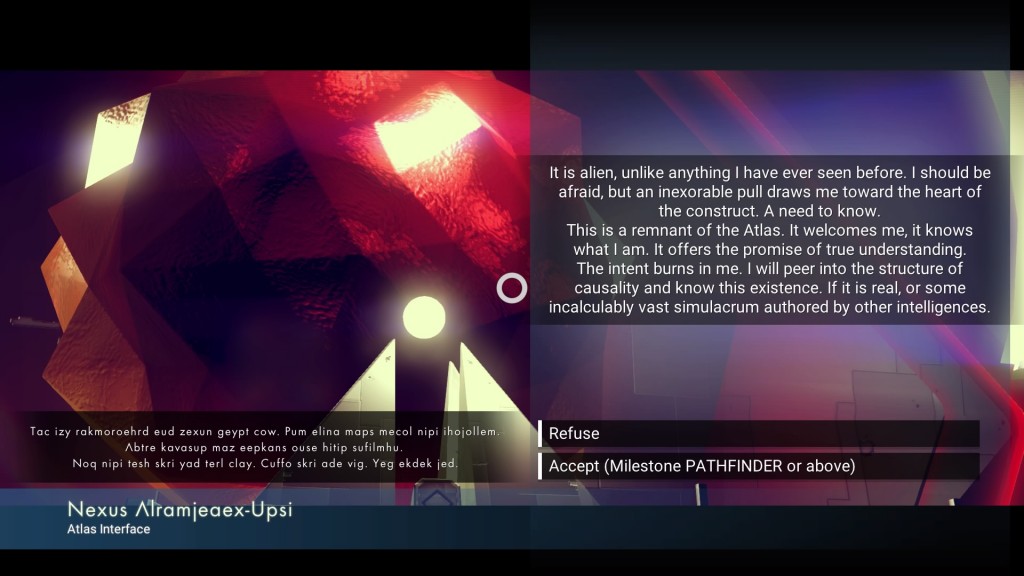What No Man’s Sky Can Learn from SFF Worldbuilding
If you follow video games, you likely have heard the hype surrounding No Man’s Sky, the space exploration game with a decided pulp science fiction aesthetic that promises a universe with a whopping 18 quintillion procedurally generated planets to discover.
If there’s one thing in this game you’ll never be short of, it’s alien, picturesque vistas
Years of anticipation culminated in the game’s release on August 9, and on that day I, along with legions of frothing gamers, lit up my Playstation, grabbed the nearest 3-liter of Mountain Dew, slid my buttcheeks into the grooves of my favorite easy chair and settled in, happily anticipating a few hundred hours of wonder-stuffed fun.
Only. Well. The game. I mean. It’s. Well.
This video sums up what millions of gamers suddenly felt at once, and were suddenly silenced.
(Video: vid.pr0gramm.com/2016/08/15/5322c9ed537c76b8.mp4)
What you just saw: the first half of the video was the trailer Hello Games, developers of No Man’s Sky, released at the 2014 E3. It’s not in-engine, but most game trailers aren’t, right? And it did its job of hyping up the gaming community for the next two years (yours truly included).
The second half of the trailer is in-engine. And oh dear: that stumbling, puffed-chested Derpasaurus Rex is emblematic of the dark side of procedural generation. Sure, you can randomly combine a wide panoply of head, torso and limb assets to create an animal’s body — if your goal is to create as many abominations as quickly as possible (among my favorites are the “ButtHalfOfADeer” at :33, “LimeHead” at 1:08, and “IfCowsWalkedOnTheirFingers” at about 4:00).
To be fair, I kind of like abominations. They’re one of Horror and SFF’s best reasons for existing, right? And we’re all SFF fans here.
Procedural generation at this scale, however, manages to drain the strangeness right out of strangeness. Once you’ve seen 27 love children of Dali and Dr. Moreau — as I did within the first few hours of play — you’ve seen ’em all. NMS‘s species-generation system feels like four parts glitch to one part working-as-intended.
And that’s, finally, where NMS misses the mark. It mistakes world-generation for worldbuilding. That’s where it could have taken a bigger hint from the science fiction genre it obviously adores, and the two master storytellers Hello Games had at their beck.
Pulp Flipbook
Visually, NMS is modeled after pulp science fiction, and while I’ve seen some complaints online about its lurid color palette, to my mind the art direction is grand slam. Players continue to upload screenshots of the landscapes of their most scenic/trippiest planets. They are easily one of the game’s highlights.
Looking at how those same pulp stories made their narratives so compulsively compelling, and modeling the player experience after them, might have saved NMS a lot of the grief it’s getting now.
They didn’t have to go far. Hello Games enlisted the help of two eminently qualified storytellers to help them develop the game world:
- Dave Gibbons — yes, that Dave Gibbons
- Novelist, comics and game writer James Swallow, who’s written for Star Trek and is one of the minds behind the story of the Deus Ex game franchise, among many other credits.
With these two SFF scions on your side, bringing decades of experience not only in multimodal storytelling, but in the case of Swallow, actual game writing credentials for one of video games’ best-told tales, how can you go wrong?
Well, here’s how. You show your game to the aforementioned scions, they write stories for you based on what they’ve seen, and then you don’t do what they do.
Gibbons and Swallow created comics for the collector’s edition of NMS, described in the video below.
video link: www.youtube.com/watch?v=eBPF7uNZUfY
One of the first thing I noted in the video is how pleasantly nonplussed Gibbons looked when describing the scale of the project, starting at 0:57:
Well, the thing is No Man’s Sky is such a kind of comprehensive universe … it’s got such scope, that in our early discussions we came to the conclusion that you could set all kinds of stories within that universe.
Scope is exactly what has drawn so many people to this game precisely because players thought they were going to get all sorts of stories. But then, when Gibbons gets down to creating his own story in the NMS universe, he severely limits the scope. At 2:35:
I chose to tell a story that was a kind of small adventure about a trader with a very valuable cargo and what becomes of the cargo because that trading aspect is one part of the game. So it’s a lot of flying about in spaceships, and a bit of humor, I think.
A “small adventure.” About a “trader.” With a “very valuable cargo.” And what “becomes of that cargo.” In just that little space you can see that Gibbons is reducing the NMS universe, its quintillions of planets teeming with life, down to a plot: the story of one trader making one cargo run. The “flying about in spaceships” (i.e. dogfights) and the “humor” will respectively introduce antagonists and give you reason to care about the protagonist.
So, courtesy of Gibbons, Hello Games has one template for mission-making: valuable cargoes, antagonists who want them dead, space battles, narrow escapes and good ol’ pulpy space adventures. Fun!
Alas. Nothing I played during or have read about the game after indicates that any such missions exist. You — and who are you, anyway? — go to a planet, you point your mining laser at mounds of plutonium sticking up from the ground (P.S. mounds of plutonium sticking up from the ground?!), you find a floating trade robot who will automagically take your plutonium or whatever from you and give you credits. Just not a lot of story there. Not a lot to bind you to this universe. (We’ll talk about the overarching Atlas mission in a minute.)
Swallow’s story (illustrated by Gibbons) focused on what Gibbons describes in the video (at 2:58) as a “visceral, internal, very gripping and engaging story of one particular character.” That “one particular character” bit is key, and it’s what Swallow expand on later in the video (at 4:00):
It’s a survival story. It’s about a character who’s shipwrecked on a planet with some unpleasant alien species chasing after them. We’ve got those sentinels that you’ve seen in the game as well. And it’s all about this character just trying to basically fix their ship and get off the planet.
The best part of NMS is the beginning of NMS. Why? Because you are shipwrecked on a strange world and must repair your ship and get off of it. Depending on the roll of the dice, your world might very well have unpleasant alien species attacking you, and it will certainly have sentinels, since every planet in the galaxy has robot sentinels (P.S. how could it be even remotely possible for these highly advanced sentinels to exist in every single planet in the galaxy?!).
In short, the beginning of NMS has a plot: you are the protagonist, pitted against time and the natural world in order to accomplish a specific and important goal. It took me several hours to fix my ship and get off my first world, partly because I was distracted by documenting the cool flora and fauna and partly because I got lost in a massive cave (which was fun to explore). Swallow’s plot and the beginning of NMS align so well, it’s hard to imagine that Hello Games didn’t just borrow Swallow’s story for the game’s tutorial.
Lesson learned, yes? Naw. NMS falls apart narratively once you leave your first planet. At the game’s start, you encounter a monument from an entity called Atlas. Atlas promises to give you life meaning. Meaning! What we all want!
Ah, you fools. You believed Atlas’ promise, too, didn’t you? What Atlas’ guidance amounts to is a paltry sprinkling of one-sentence missions to tell you what to do next. You get about a fourth of those missions at the beginning. The rest of the time, your missions are mostly to gather stuff to craft the fuel you need jump to the next star system. They’re about as fun as grocery shopping for the same seven items.
Here is where NMS disappoints most. Every new planet you encounter should be a major event. In history. Let’s ignore for the moment the fact that there are camera robots everywhere in the universe who got there before you: the advances every one of these planets represent, in geology, physics (there are floating rocks on planets I encountered), chemistry and especially biology, is boggling. It’s the part of the middle game I enjoyed most, and even now, post disappointment, I still remember fondly.
The problem is that no one cares what you found. No scientist gives you missions to collect samples or species, no government wants maps of ocean or cave, no private collector wants you to grab something especially deadly and exotic. The grandeur of discovery is reduced to you getting a few credits from an anonymous source. You don’t have to name your discovery if you don’t want to, and if you name it something vulgar or absurd, no one thinks it’s funny, and no one cares. There is more or less no one in this game.
Now. There is an argument to be made that the game explains why the universe feels so empty. But to describe it, I must first warn you of
Spoilers!
Ready? Here’s the big reveal.
The universe may just be a simulation.
*cough*
The upshot of this gnomic speech is, “Will you or will you not continue doing what Atlas tells you?” This way, we can figure out if we exist for our own sake, or for the sake of some higher power that’s playing us like a video game.
The question is this: given how empty the game is of content, raison d’être, and purpose, the question becomes: “Why would you think the universe is anything other than a simulation?”
Here’s the thing: writing a meta-game could have worked. NMS could have been the first game to successfully leverage some of physics’ more recent theories about the nature of the universe. It doesn’t work here simply because a meta-idea can’t work on its own. It needs to be set against something. Pirandello had his six characters in search of an author. This game is in search of content.
More specifically, this is a game that needs plots. Lots of them: a series of microplots characters can choose from, so that they can carve their own path through a nigh-infinite universe. How exactly to get that content is no easy question to answer: player-provided content might feel like a way to go, but if game history is any indication, game players are more interested in being opponents than storytellers. The notorious dearth of quality missions in Spore, which gave its players the chance to make adventures for other players, provides one counter-example to the notion that if you create tools for players, they will do the design heavy-lifting.
Mileage varies from game to game — I remember several quality player-made adventures from the original Neverwinter Nights — but in a game that has set its procedural heights as high as NMS has, figuring out a way to make the universe compelling, so that then the “maybe it’s all a simulation” ending can startle players even as it resonates, is a design challenge as daunting as the ones NMS succeeds at.
And make no mistake: NMS is laden with design successes. It’s a remarkable game in many ways, especially when you consider how tiny it is, file-wise! But it’s too tiny at the end of the day. If a tree falls on a planet no one has discovered because they got bored playing the game, does it make a sound? The creators of this simulation may never know, since they haven’t created enough motivation for their test subjects to keep the experiment going.
You can read reviews of Carlos’s first collection of SFF stories, The Assimilated Cuban’s Guide to Quantum Santeria, at Tor, Publishers Weekly, Locus and Lightspeed. By day, Carlos is a CUNY English professor who helped found the CUNY Games Festival, the first conference on game-based learning focused on postsecondary education. He’s also the lead writer on the Lewis and Clark CRPG Meriwether (coming soon!), the literary consultant on the forthcoming iPhone game Losswords, and a contributor and consultant on numerous other games.



I kind of chuckled when I heard that the game failed to deliver on most of its promises, but then i got sad.
We had that wonderful post by Neil Baker a couple weeks ago about how much he was looking forward to the game. It was bringing in older gamers that hadn’t done anything like that for years or ever. How many people were disappointed after weeks of looking forward to it.
IF I were a gamer, which I’m not (I played a couple in 1986, I think) that would put me off and probably tick me off for the wasted cash. Really, awful. So that’s as good as game graphics has gotten? Really? Good thing I’m into books. The kind printed on paper.
Best descriptions Ive seen:
No Man’s Sky…good $20 early access…terrible $60 dollar final release.
and
5 minutes of story, 50 hours of using a laser pointer on rocks.
Either of which would be fine, if the developers didnt flat out lie about their product. Yes Im saying they lied because while lots of developers promise things they cant/dont deliver on, I have little doubt that the guys behind NMS knew what their game was when they were still making multiple promises that turned out to false.
With respect “Pulpy”?
Like, did I miss the patch where the alien civs had evil orientalist emperors, sexy slave girls, guards in quasi fascist uniforms or animal style suits? Giant monsters, air boats, lovecraftian monsters? Where you could be a mystic crystal swordsman or a rocket ranger with a rocket pack and a laser pistol and an asbestos space suit for dealing with the swealtering jungles of venus and enemy tripod heat rays?
On No Man’s Sky I didn’t want to be “Captain Bring Down” but my senses said “The Vaporware is strong in this one…” and am quite surprised to see it even finished – much less lackluster after a major delay or so. Neat graphics, but stuff you can get in almost any “Indie” game, even stuff like “Salt” or “Proteus” just a matter of using existing game engines and playing with the graphics.
IMO if you want an open space go anywhere in abstract theory infinite game with any sort of good scifi appeal, even a little Pulp try “Starbound”. It’s 2d and retro/pixel style and proud of it. But within it you find an open universe with tons of well thought out procedurally generated worlds and alien creatures. And there are neat major races, both a tribute to and a break from classic science fiction.
My favorite is the “Floran” which is a race of plant humanoids. They are both the oldest race in the galaxy – having evolved around a red dwarf star but thee youngest in that only recently did they get space travel. Now, if you don’t know you might think Plant ike = peaceful, nature loving, mystical…? Well, imagine a world where plants were the only major life so nature had to force some to take the role of higher animals, such as the venus flytrap who since it couldn’t just ouput nectar and wait for something to crawl up the right/wrong leaf…
So they are brutal, savage, tribal creatures – by stereotype… The first ones were. Explorers came to their world thinking “Wow, walking plants, we can buy their world for a box of beads then strip mine it… But they go in and the translator says “Meat… MEAT TO EAT!!!” then they get the ships, replicators, guns. They have ZERO technological creative capability but they can absorb, copy, adapt, learn to any existing situation. So the tribes stopped warring with knowledge of other worlds, built a lot of ships and went to the next world, almost genociding a race of frog like creatures who’s tech resembeled the western image of the Orient… It would have been a “Blight” worthy of Stapledon’s “Star-Maker” but the Floran only cared about spreading out amongst the stars and finding new grounds for their tribes. Still that first interaction and their continuing love of the primitive natural ways (brutal tribal ritual and savagery) give them a bad name – those that go independant and try to live amongst other races face scorn from both those they try to befriend “Get away from me, Floran scum!” and their own poeple “Outwalker! Defier of true ritual! Stab! Sssstabbb!”
Needless to say this is a game I love, and that’s only the surface. Had to leave it uninstalled after a crash to get any storywork done…
GreenGestalt–I will check out _Starbound_; looks interesting! And while we are passing around suggestions, I have good things about _Rimworld_ re: narrative meets procedural generation.